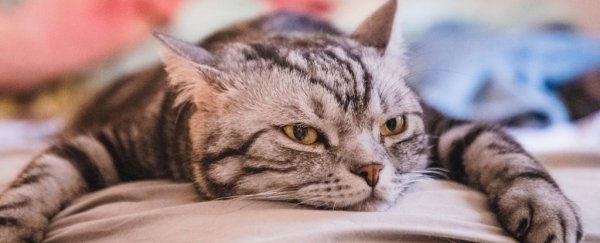SARS-CoV-2 is not picky about its host. Since the virus first started spreading among humans, it has jumped from our species to pets, livestock, and even wild animals.
Cats appear to be particularly susceptible to contracting COVID, although they often don't show symptoms, and it's unlikely that they can pass the virus back to us. Even amongst each other, there appears to be low transmission.
Still, if SARS-CoV-2 is silently circulating among our pets, there's always a chance it could mutate into something even more dangerous, spreading from household to household via a community of free-roaming cats and dogs.
That's why some scientists are trying to track COVID variants among our household pets. And, at least for now, it seems like there's little to worry about.
A new study reports the case of a domestic house cat in southeastern Pennsylvania, which was diagnosed as having SARS-CoV-2 in September 2021. Subsequent genome testing has since identified the infection as the Delta variant AY.3 – the same variant circulating amongst humans in the area at the time.
This confirms that newer COVID variants (up to Delta, at least) are still spilling over to our pets, which is unfortunate. But on the upside, the results here suggest the virus may not be mutating much in our feline companions.
Of all 4,200 human samples of coronavirus that were sequenced in Delaware, Pennsylvania, less than 5 percent contained the 10 single nucleotide variants found in the domestic cat's sample.
What's more, seven of these 10 mutations were silent, meaning they did not cause significant changes.
"When we looked at a random sampling of human sequences from our geographic area, there wasn't anything dramatically different about our cat's sample," explains veterinarian Elizabeth Lennon from the University of Pennsylvania.
"So, our takeaway was that the cat was not infected by a virus that was somehow highly different."
The study is the first to officially identify a delta variant among domestic cats in the US. Although, at the time of research, the authors became aware of another cat from Virginia that had contracted the AY.3 variant about a month earlier.
Both cat-derived AY.3 genomes showed few single nucleotide variants compared to human-derived samples, which is a good sign, albeit from a tiny sample size.
"Some of these mutations may be enriched in samples from cats; however, a larger dataset is necessary to draw this conclusion," the authors write.
Interestingly, in the domestic cat from Pennsylvania, a nasal swab did not identify SARS-CoV-2, while a fecal test did. This might represent different physical reservoirs for the virus among different species, or it could be that the cat was tested after the infection had progressed from nose to butt.
Some humans who contract COVID, for instance, continue to show positive fecal samples on average more than 11 days after their respiratory tract results drop below detectable levels.
"This did highlight the importance of sampling at multiple body sites," says Lennon.
"We wouldn't have detected this if we had just done a nasal swab."
At the time the cat was brought in for medical care, it had been suffering from anorexia, lethargy, vomiting, and soft stools for several days. Its owner had contracted SARS-CoV-2 just 11 days before, but had since been isolating from their pet for fear they'd make them sick.
By the time the cat was found to have COVID, it was too late to get a swab from the pet owner to compare the two viral infections, which means we don't know how the cat got infected or what about its infection allowed the virus to jump over the species barrier.
The fact that this is the first official report of a cat contracting the AY.3 lineage suggests we can't become complacent about transmission among our pets.
"A main takeaway here is that as different variants of SARS-CoV-2 emerge, they seem to be retaining the ability to infect a wide range of species," Lennon says.
SARS-CoV-2 itself is probably derived from closely related pathogens in bats or pangolins. Once the virus jumped to humans and began spreading with alacrity, it also began to mutate. Some of the changes have meant that animals, like deer mice, once unable to be infected by the virus now can be.
Thanks to COVID's ever-changing nature, any viral reservoir poses a danger to humans and other animals. Just because cats don't appear to be driving mutations or transmission now doesn't mean that will always be the case.
The study was published in Viruses.
